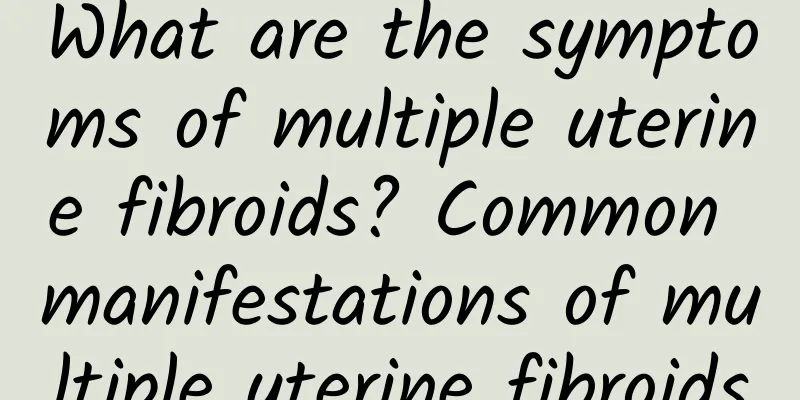What are the symptoms of multiple uterine fibroids? Common manifestations of multiple uterine fibroids

|
The symptoms of multiple uterine fibroids in the early stage are not obvious, and some women usually have no symptoms in the early stage, which is often very unfavorable to the development of the disease. Therefore, experts remind female friends that the key is to understand the symptoms of multiple uterine fibroids as soon as possible in order to better prevent and control the disease. The symptoms of multiple uterine fibroids are usually different for each person, mainly related to the size, location and growth rate of the fibroids. The common clinical symptoms of multiple uterine fibroids are mainly the following: 1. Menstrual changes: This is a very common symptom, which is usually prone to menorrhagia, prolonged menstruation, and even irregular vaginal bleeding. Submucosal fibroids usually cause menorrhagia, and as the fibroids grow larger, the menstruation becomes longer. Once the fibroids become necrotic, ulcerated, or infected, there will be persistent or irregular vaginal bleeding or purulent expansion fluid. Subserosal fibroids and intramural small fibroids often do not have obvious menstrual changes. 2. Abdominal mass: Patients with uterine fibroids are prone to symptoms of abdominal mass, which is easier to touch in the morning when the bladder is full. It is hard in texture and irregular in shape. 3. Bleeding: Submucosal fascia and myoma increase the area of uterine cavity and increase menstrual volume. 4. Abdominal pain, backache, lower abdominal swelling: Patients usually have no abdominal pain, but acute abdominal pain occurs when the pedicle of the subserosal fibroid is twisted. When the fibroid is red, the abdominal pain is severe, accompanied by fever. Lower abdominal swelling and back pain are common, and menstruation is aggravated. 5. Compression symptoms: Myoma compresses the bladder, causing frequent urination, urinary dysfunction, urinary retention, etc. Compression of the ureter can cause hydronephrosis, and compression of the rectum can cause difficulty in defecation. 6. Infertility: According to literature reports, it accounts for 25% to 40%. It may be that the fibroids compress the fallopian tubes and deform the uterine cavity, hindering the implantation of the fertilized egg. 7. Secondary anemia: Long-term menorrhagia leads to secondary anemia. In severe cases, symptoms include general fatigue, pale complexion, shortness of breath, palpitations, etc. In addition, increased vaginal discharge is also a more common symptom of multiple uterine fibroids. Of course, many gynecological diseases will cause increased vaginal discharge, so it is inaccurate to judge uterine fibroids only by abnormal vaginal discharge. We must choose regular hospital diagnosis is the most important. |
<<: What are the dangers of multiple uterine fibroids? Will multiple uterine fibroids worsen?
Recommend
Common causes of vulvar leukoplakia
Because people do not pay much attention to the d...
When it comes to losing weight, the most common thing people do is to stop eating starch. But is this really the right thing to do?
When it comes to losing weight, the most common t...
My period is almost over after three days, but it is not clean. What's wrong?
My period is almost over after three days but it ...
What are the consequences of vulvar itching?
What are the hazards of vulvar itching? Modern li...
What is the cause of the harm caused by uterine fibroids?
There are many diseases in the uterus, and the mo...
Differentiation between primary amenorrhea and androgen insensitivity syndrome
Patients with androgen insensitivity syndrome hav...
Drink skim milk to lose fat? Study: Children are more likely to be obese
Milk is a healthy drink for children to supplemen...
Experts explain common physical therapies for treating cervical hypertrophy
Physical therapy is a common method for treating ...
A brief discussion on the etiology of bacterial vaginosis
Bacterial vaginosis is one of the most common gyn...
What causes symptoms of hydatidiform mole pregnancy
Treatment for hydatidiform mole includes uterine ...
Is there any shadow? Eating rice to lose weight can avoid starvation
Rice has always been an inconspicuous but indispe...
What are the early symptoms of missed abortion? We must pay attention to it
The early symptoms of missed abortion mainly incl...
A 24-year-old woman had an itch on her abdomen, and the doctor used tweezers to remove 16 pubic lice! It turns out that there are 4 ways of transmission
Xiaoli, a 24-year-old young woman, is experiencin...
How to prepare for pregnancy after surgery for chronic cervicitis Tips for women to prepare for pregnancy after surgery for chronic cervicitis
Chronic cervicitis is one of the common diseases ...
Lai Qingde personally watched the pig farm insist on zero detection of clenbuterol
On the 20th, Tainan Mayor Lai Ching-te visited th...









